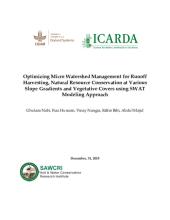Land Library
Welcome to the Land Portal Library. Explore our vast collection of open-access resources (over 74,000) including reports, journal articles, research papers, peer-reviewed publications, legal documents, videos and much more.
/ library resources
Showing items 1 through 9 of 74.The present document is a brief technical report highlighting activities relating to the options by context approach. The IFAD- funded project, “Restoration of degraded land for food security and poverty reduction in East Africa and the
This study was carried out at the communal rangelands of Dhahar, Saharan area of Southern Tunisia, to assess the impact of restoration and rehabilitation techniques on natural vegetation cover.
Since, the Common Agricultural Policies (CAP) reform in 2003, many efforts have been made at the European level to promote a more environmentally friendly agriculture.
The article starts from the premise that agricultural bioenergy crop production has massive influence in changing the land use paradigm in Romania, due the fact that important land surface areas are cultivated with such crops because of the increasing demand of biofuels.
The extent to which REDD+ initiatives should be a mechanism to address poverty and provide other co-benefits apart from carbon storage, is hotly debated.
Ecosystem-based adaptation (EbA) measures have been increasingly promoted in the literature, as well as in policies and practices, for their environmental and socio-economic co-benefits.
Gedaref State was previously known as the
food basket of Sudan. Over several decades
unsustainable agricultural practices that
combined near-monocropping with low nutrient
replenishment have led to significant degradation
Report on application of SWAT model for soil conservation planning. A study was undertaken to evaluate the soil erosion parameters using semi-distributed
basin scale SWAT model in different watersheds of Chakwal and Attock districts. The
This issue of Caravan showcases some of ICARDA’s efforts of coping with climate change in dry areas with improved water land management and resilient production systems.






